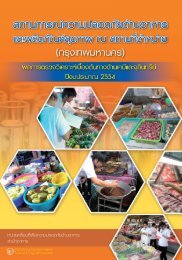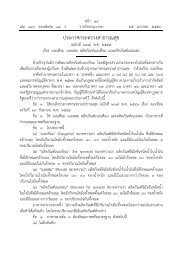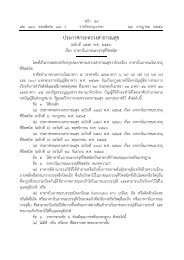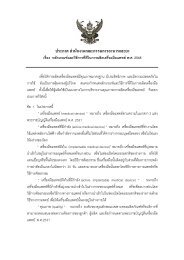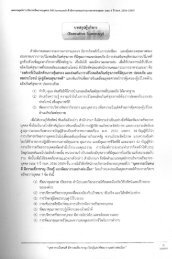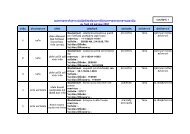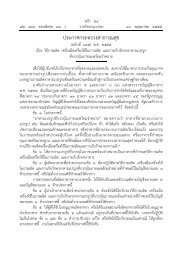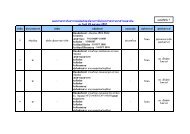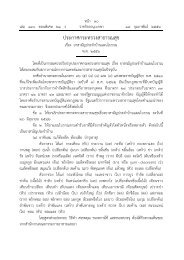Food Safety Forum
Food Safety Forum
Food Safety Forum
Create successful ePaper yourself
Turn your PDF publications into a flip-book with our unique Google optimized e-Paper software.
<strong>Food</strong> safety: New Challenge►New New Technology and <strong>Food</strong> <strong>Safety</strong>►กิจกรรมเพื่อพัฒนาระบบมาตรฐานความปลอดภัยอาหารของประเทศ ที่ BIOTEC ดําเนินการ►VethachaiVethachai Plengvidhya►<strong>Food</strong> <strong>Food</strong> Biotechnology Laboratory►National National Center for Genetic Engineering and Biotechnology (BIOTEC)National Science and Technology Development Agency (NSTDA)► E-mail:vethachai@biotec.or.th
New technology and food safety• Biotechnology• Nanotechnology/ Nanobiotechnology
Biotechnology• Biotechnology can offers effective techniquesto address consumer concerns about safety offoods• Biotechnical methods may be used to• Decrease the time necessary to detect foodbornepathogens, toxins, and chemical contaminants andto increase detection sensitivity.• Monitor food production and processing systems forquality control• Improve production process
Biotechnology• These developments can offer thepotential of lowering the cost andimproving the safety of the food supplyin a timely manner.• Genetic fingerprinting techniques• Downstream processing• Biosensor
Genetic fingerprintingtechniques• Monitoring product safety and quality.• Recognizing outbreaks of foodbornepathogen• Determining the source of the infection androute of transmission.• Recognizing particularly virulent strains oforganisms.• Monitoring correction programs.
Genetic fingerprintingtechniques• These type of activity can be accomplished bya number of different approaches.• The selected methods must meet severalcriteria in order to be broadly useful• All organisms within a species must be typeable bythe method used.• Selected method must have high differentiationpower• Selected method must have acceptablereproducibility
Genetic fingerprintingtechniques• Pulse-field gel electrophoresis• PCR-based detection techniques• Fluorescence in situ hybridization
Pulse-field gelelectrophoresis (PFGE)• A macrorestriction analysis which usesrestriction enzymes that cut genomicDNA into large fragments.• The restricted DNA is subjected toelectrophoresis which the orientation ofthe electric field across the gel isperiodically changed.
PCR-based detectionsystems• PCR is an in vitro method for theenzymatic synthesis of specific DNAsequences• The oligonucleotide primers used inPCR reactions are designed fromknowledge of a known DNA sequencethat surrounds the region of interest.• There are variety of PCR-baseddetection methods available forselection
Fluorescence in situhybridization (FISH)• This technique is the in situ detection andidentification of whole cells with genetargeted made permeable for specificfluorescently labeled oligonucleotides.• A variety of probes can be developed forFISH, depending upon the desired bindingsensitivity.
Downstream processing• The isolation, purification and sterilization of end products.• Preservation and sterilization• Inhibits, destroys or removes and prevents re-entry of pathogenic andmicroorganisms that cause spoilage• Restricts adverse biochemical and biophysical change.
Downstream processing• Thermal processes and alternatives• Existing processes that reduce heat damage include• Spray-drying• Tubular and scraped surface heat exchangers• Steam injection followed by aseptic packaging• Several alternative means of preservation are in various stages of investigation anddevelopment.
Downstream processing• Irradiation• Apart from consumers' suspicions, still evident, the main constraints to foodirradiation are economic.• Capital costs are high, emissions from radioactive isotopes cannot be switched off,so to derive maximum benefit there must be a constant supply• Needed skilled staff to ensure safety of all workers who must come close to theequipment.
Downstream processing• Ohmic heating• When an electric current flows through a substance of suitable conductivity, heat isuniformly generated.• The fluid is pumped through a column between two electrodes between which thecurrent passes. The sterilised product is rapidly cooled and passes aseptically intosterile containers.• Heating is uniform and of short duration.• Ohmic heating is effective for fluids and particles suspended in fluid media.
Downstream processing• Microwave (MW) and radio frequency (RF) heating• MW and RF depend on electromagnetic energy generated from a magnetron toproduce an electric field that alternates at radio or microwave frequencies.• Heat is generated in biological materials by rapid reversal of molecular polarization.• MW and RF provide uniform, short-time heating with high internal temperatures
Downstream processing• Ultra-high hydrostatic pressure (UHP)• Lethal effects on microorganisms of isostatic pressures between 500 and 10 k bar(50 kPa–1 MPa) were discovered over a century ago.• UHP food processing has been applied mainly to fruit juices and jams.• UHP minimizes loss of nutritional and functional properties.
Downstream processing• Pulsed energy• Three forms of pulsed energy for microbial inactivation are under study• Pulsed electric fields (PEF)• Pulsed light (PL)• Pulsed magnetic fields (PMF).
Downstream processing• Ultrasonics (US)• Ultrasonics use sound waves at frequencies higher than detected by human ears (20kHz).• Microbes in liquid suspension are inactivated by alternating pressures andcavitation
Biosensor• Biosensors offers great promise for improving foodprocessing, analysis, and safety assurance.• Enzymes, antibodies, and microbial cells can beimmobilized on solid surfaces• The highly specific actions of biological moleculescan be exploited for use in biosensors that canmeasure the concentration of specific componentsin complex mixtures.• The specific reactions they mediate can be detectedby various physical and chemical means
Biosensor• Development of tailor-mademembranes capable of separatingmolecules based on• Size• Electrical charge• Solubility• These will accelerate biosensordevelopment
Biosensor• Advances in the semiconductor industry have madeit possible to combine chemical and biologicalcomponents and integrated circuits in miniaturizedsystems.• Biosensors can be inserted directly into foodprocessing streams to obtain on-line, real-timemeasurements of important food processingparameters.• Miniature biosensors also could be incorporated intofood packages to monitor temperature stress,microbial contamination, or remaining shelf life,and to provide a visual indicator to consumers ofproduct state at the time of purchase.
Nanotechnology• Understanding and applying atomic or molecular level manipulationand assembly of structures.• Nanotechnology will be developed at several levels• Materials• Devices• Systems• The nanomaterials level is the most advanced at present
Nanobiotechnology• Nanobiotechnology combines biotechnology and nanotechnology.Both fields manipulate materials at the atomic level.• Nanobiotechnology can be used to make atomic-scale machines byimitating or incorporating biological systems at the molecular level, lorto build tiny tools to study or change natural structure properties atomby atom.• Develop more sensitive, less expensive and faster ways to detectfoodborne pathogen and contaminants
กิจกรรมเพื่อพัฒนาระบบมาตรฐานความปลอดภัยอาหารของประเทศ (BIOTECดําเนินการ)• การเสริมสรางโครงสรางพื้นฐานของประเทศ (Capacity Building)• การสงเสริมและสนับสนุนโครงการวิจัยดานมาตรฐานอาหาร(Research Funding)• การพัฒนาบุคลากรในภาคการผลิต (Human ResourceDevelopment)• การศึกษาวิจัยเชิงนโยบาย• การประเมินความปลอดภัยของอาหารดัดแปรพันธุกรรม(GM <strong>Food</strong>)
การเสริมสรางโครงสรางพื้นฐานของประเทศ• รวมกับสถาบันอาหาร กระทรวงอุตสาหกรรม จัดทําโครงการ “การพัฒนามาตรฐานสุขอนามัยและความปลอดภัยในอุตสาหกรรมอาหารแหงชาติ”• จัดตั้งหนวยความปลอดภัยอาหาร (<strong>Food</strong> <strong>Safety</strong> unit) เพื่อใหบริการดานวิชาการและคําปรึกษาดานการจัดทําระบบมาตรฐานความปลอดภัย(GHP / GMP / HACCP) ใหกับกลุมวิสาหกิจ ชุมชน และอุตสาหกรรมอาหารขนาด SMEs
การสงเสริมและสนับสนุนโครงการวิจัยดานมาตรฐานอาหาร• สนับสนุนโครงการวิจัยดานมาตรฐานอาหารไปแลวจํานวน 10โครงการ• สํานักงานมาตรฐานผลิตภัณฑอุตสาหกรรม (สมอ.)ไดนําผลงานจากการวิจัยไปใชเปนขอมูลในการจัดทํามาตรฐานใหมสําหรับผลิตภัณฑปลารา และใชเปนขอมูลในการปรับปรุงมาตรฐานผลิตภัณฑแหนม ซึ่งออกมาแลวตั้งแตป 2537
การพัฒนาบุคลากรในภาคการผลิตสรางที่ปรึกษาฝกหัดเพื่อใหบริการและถายทอดเทคโนโลยีดานกระบวนการแปรารแปรรูปอาหารและสุขลักษณะที่ดีในการผลิตอาหาร (GHP / GMP / HACCP)จัดอบรมหลักสูตร Better Process Control Schoolจัดเสวนาความปลอดภัยอาหาร (<strong>Food</strong> <strong>Safety</strong> forum)พัฒนาบุคลากรดานการตรวจวิเคราะหคุณภาพสุราพื้นบานโดยมุงเนนการพัฒนาบุคลากรในสถาบันราชภัฎภัฎและสถาบันเทคโนโลยีราชมงคลและสถาบันเทคโนโลยีราชมงคล(ซึ่งเปนหนวยงานหนึ่งที่ไดรับมอบหมายจากกรมสรรพสามิตใหเปนหนวยงานรับตรวจวิเคราะหคุณภาพสุราพื้นบาน)
การศึกษาวิจัยเชิงนโยบาย• ดําเนินการศึกษาวิจัยเชิงนโยบายและจัดทําขอเสนอแนะเชิงนโยบาย(PolicyOptions)ดานความปลอดภัยอาหารสําหรับประเทศไทย• “ขอเสนอเชิงยุทธศาสตรและแผนที่นําทางการจัดทํามาตรฐานระบบการผลิตและมาตรฐานสินคาเกษตร สินคาเกษตรแปรรูปและอาหาร เพื่อการสงออกและนําเขา”• “การจัดทําขอเสนอเชิงยุทธศาสตรและแผนที่นําทางการพัฒนาใหสํานักงานมาตรฐานสินคาเกษตรและอาหารแหงชาติ (มกอช.) เปนสถาบันรับรองระบบงาน(Accreditation Body) ดานระบบคุณภาพความปลอดภัยสินคาเกษตรและอาหาร”
การศึกษาวิจัยเชิงนโยบายรวมกับสถาบันคลังสมองของชาติ ทบวงมหาวิทยาลัย สมาคมวิทยาศาสตรและเทคโนโลยีทางอาหารแหงประเทศไทย(FoSTAT) กลุมอุตสาหกรรมอาหาร สภาอุตสาหกรรมแหงประเทศไทยและสถาบันวิจัยโภชนาการ มหาวิทยาลัยมหิดล จัดทําโครงการ “การศึกษานโยบายความปลอดภัยอาหารของประเทศ”
การประเมินความปลอดภัยของอาหารดัดแปรพันธุกรรม (GM <strong>Food</strong>)• คณะอนุกรรมการเพื่อความปลอดภัยทางชีวภาพดานอาหาร ทําหนาที่เปนที่ปรึกษาดานวิชาการใหแกสํานักงานคณะกรรมการอาหารและยา ในสวนของการประเมินความปลอดภัยของอาหารที่ไดจากสิ่งมีชีวิตดัดแปรพันธุกรรม• การประเมินความปลอดภัยของน้ํามันจากเมล็ดฝายบอลลบอลลการด• ถั่วเหลืองดัดแปรพันธุกรรม• ขาวโพดดัดแปรพันธุกรรม• มะละกอดัดแปรพันธุกรรม• สับปะรดดัดแปรพันธุกรรม
การประเมินความปลอดภัยของอาหารดัดแปรพันธุกรรม (GM <strong>Food</strong>)• ไดจัดทําโครงการเพื่อเผยแพรและสรางความเขาใจแกสาธารณชนเกี่ยวกับขอมูลที่ถูกตองทางวิทยาศาสตรในเรื่องของสิ่งมีชีวิตดัดแปรพันธุกรรม อาหารที่ไดมาจากสิ่งมีชีวิตดัดแปรพันธุกรรมเหลานี้ และความปลอดภัยทางชีวภาพ
แผนงานดานความปลอดภัยอาหารในอนาคต ประสานงานใหเกิดโครงการะดับชาติดาน “การจัดการดานการประเมินความเสี่ยงอาหารดวยวิทยาศาสตรและเทคโนโลยี” <strong>Food</strong> Policy <strong>Forum</strong> เพื่อใหเกิดบรรยากาศการแลกเปลี่ยนความคิดเห็นเชิงนโยบายในดานอาหารของประเทศ โดยเนนประเด็นสําคัญๆ และ/หรือเรงดวน (hot issues) เชน นโยบายดานความปลอดภัยของอาหาร เปนตน เพื่อนําไปสูการศึกษาวิจัยในประเด็นที่ไดจากเวทีแลกเปลี่ยนความคิดเห็น และผลักดันใหมีขอตกลง ขอปฏิบัติ หรือความรวมมือ ในประเด็นตางๆ ที่ไดจากเวที <strong>Food</strong> Policy <strong>Forum</strong>
แผนงานดานความปลอดภัยอาหารในอนาคต สนับสนุนการพัฒนาหองปฏิบัติการตางๆ• หองปฏิบัติการวิจัยชุดตรวจวินิจฉัยโรคที่สําคัญในสัตวเศรษฐกิจของประเทศระเทศไทย• หองปฏิบัติการทางไวรัสไวรัสวิทยา วิทยา• หองปฏิบัติการตรวจสอบสารตกคาง / สารพิษ ใน วัตถุดิบและผลิตภัณฑอาหาร เสริมสรางความเขมแข็งของหองปฏิบัติการตรวจวิเคราะหคุณภาพความปลอดภัยอาหาร และหองปฏิบัติการตรวจวิเคราะหความเสี่ยงอาหาร ใหเปนที่ยอมรับในระดับสากล
แผนงานดานความปลอดภัยอาหารในอนาคต สนับสนุนใหเกิดการจัดทําระบบ Recall และ Trace Back เพื่อสรางความเชื่อมั่นใหผูบริโภคภายในประเทศและประเทศคูคา ในกรณีที่เกิดความไมปลอดภัยตออาหาร สนับสนุนใหเกิดการพัฒนาความเขมแข็งของ Certification Body (CB)ของประเทศไทย สนับสนุนและสงเสริมใหเกิดการเพิ่มจํานวน CB ในภาคเอกชน เพื่อตรวจประเมินระบบความปลอดภัยตลอดหวงโซอาหาร พัฒนาหลักสูตรการประกันคุณภาพขั้นพื้นฐานสําหรับบุคลากรในโรงงานอาหาร
แผนงานดานความปลอดภัยอาหารในอนาคต พัฒนาฐานขอมูลผูเชี่ยวชาญที่เกี่ยวของกับความปลอดภัยอาหารของประเทศไทยเทศไทยเชน ผูเชี่ยวชาญดานการประเมินความสี่ยง พัฒนาฐานขอมูล Detention List ที่เปนปญหาของประเทศไทย โดยรวมมือกับสถาบันอาหาร พัฒนาฐานขอมูลเกี่ยวกับกฎระเบียบและมาตรฐานตางๆ และสนับสนุนให AMCมีกฎระเบียบที่สอดคลองกัน (Harmonization) สนับสนุนการวิจัยดานความปลอดภัยอาหาร (<strong>Food</strong> <strong>Safety</strong> Research) เชน การประเมินความเสี่ยงของอันตรายที่วิเคราะหได (Risk Assessment), การบงชี้ของอันตรายที่อาจเกิดจากอาหาร (Hazard Identification) และการหาแนวทางปองกัน
แผนงานดานความปลอดภัยอาหารในอนาคต สนับสนุนการวิจัยและพัฒนาวิธีการตรวจหาเชื้อกอโรคอยางฉับพลันและสะดวกตอการใชงาน สนับสนุนการวิจัยเพื่อพัฒนาวิธีการตรวจสอบสายพันธุเชื้อกอโรคที่แมนยํา เชน วิธี DNA Sequencing เปนตน สนับสนุนการวิจัยดาน Hurdle Technology เพื่อยับยั้งการเจริญเติบโตของเชื้อกอโรค แลกเปลี่ยนขอมูลระหวางผูเชี่ยวชาญ เชน ขอมูลเกี่ยวกับผลิตภัณฑGMO เปนตน เผยแพรความรูที่เกี่ยวของกับเรื่องความปลอดภัยอาหารอยางตอเนื่อง



